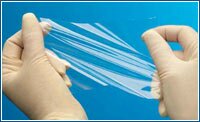|
|
 |
 |
| Home » USA Products » Bioresorbable Thin Film |
 |
Bioresorbable Thin Film
Building on its initial biomaterials platform technology, MacroPore Biosurgery has developed bioresorbable surgical thin films for temporary wound support or to reinforce soft tissues where weakness exists. This proprietary technology has clinical applications across multiple surgical specialties.

The Evolution of Bioresorbable Thin Film
Before the advent of bioresorbable materials, the closure of soft tissue was limited to permanent materials such as nylon sutures. Advances in material sciences led to the development of bioresorbable polymer sutures that met the clinical needs of holding soft tissues together, while serving the patient's need of not remaining permanently in the body.
The evolution of bioresorbable polymer technology facilitated the development of large bioresorbable polymer films that could span large tissue masses and subsequently hold them in place. The thin films facilitate the healing of larger tissue masses and virtually eliminating many adverse effects of permanent implants.
Bioresorbable Material
Bioresorbable surgical thin films, for soft tissue applications, are made from polylactide (PLa): a copolymer of 70:30 Poly(L-lactide-co-D,L-lactide). Composed of lactic acid similar to that which occurs naturally in the human body, the copolymer maintains its strength during the healing process, and through hydrolysis slowly breaks down into lactic acid molecules. The molecules are ultimately metabolized into carbon dioxide and water and are released from the body through the lungs.
Bioresorbable Thin Film Advantages
- Transparent, ultra thin profile to allow simplified intraoperative placement and repositioning without obscuring visualization of underlying tissues.
- Significant strength retention for up to 8 weeks to maintain support throughout critical healing period.
- Bioresorbable/biocompatible material provides safe resorption and metabolization with minimal risk of inflammatory reaction.
- No human or animal components, avoids the risk of disease transmission.
Thin Film US Regulatory Clearances
- In November 2001, MacroPore Biosurgery received its first regulatory clearance from the FDA to market reconstruction film for the prevention of postsurgical adhesions in specific ENT (ear, nose and throat) procedures.
- In December 2001, bioresorbable film received FDA clearance for soft tissue support and for the repair of fascial defects including vaginal prolapse repair, colon and rectal prolapse repair, and reconstruction of the pelvic floor.

|
 |
|
 |



